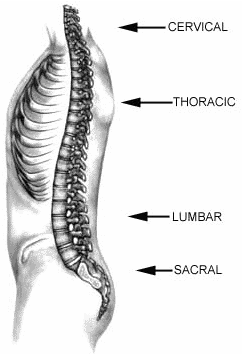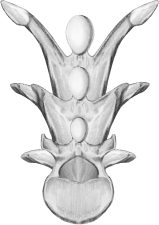THE SPINE
Know Your Spine
 The spine is one of the most vital parts of the human body, as it supplies all of our vital organs with information from the central nervous system.
The spine is one of the most vital parts of the human body, as it supplies all of our vital organs with information from the central nervous system.
Upper Neck, Upper Cervical Spine (C1 - C2)
Head, face, upper neck, inner & middle ear, sympathetic nerve system, sinuses, eyes, auditory nerves and more.
Mid/Lower Neck, Cervical Spine (C3 - C7)
Neck, shoulders, thyroid, tonsils, teeth, outer ear, nose, mouth, vocal cords, and more.
Mid Back, Thoracic Spine (T1 - T12)
Arms, hands, heart, coronary arteries, esophagus, trachea, lungs, bronchial tubes, gallbladder, liver, stomach, pancreas, spleen, kidneys, ureters, adrenal glands, small intestines, and more.
Lower Back, Lumbar Spine (L1 - L5)
Large intestines, appendix, abdomen, bladder, reproductive organs, lower back, lower extremities, ankles, feet, and more.
Basebone or Tailbone, Sacrum and Coccyx
Hip bones, tail bone, buttocks, rectum, anus, and more.
The anatomy of the spinal column is extremely well designed to serve many functions. Protecting the spinal cord, of which provides communication to the brain, mobility and sensation in the body. The back is also the powerhouse for the entire body, supporting and allowing the movements of our head, arms, and legs possible.
The human spine consists of 33 vertebrae, but as we go through the teenage years, natural fusion occurs leaving us with 26 articulating segments. There are 7 cervical (neck region), 12 thoracic (chest region), 5 lumbar (lower back region), 5 sacral (hip region), and 4 coccygeal (tailbone region) vertebrae. The vertebrae are held in place by muscles and strong connective tissue called ligaments. Most vertebrae have fibrous intervertebral disks between them to absorb shock and enable the spine to bend.
The spine normally has a slight curve. Abnormal curvatures may be present at birth. They may also result from disease, poor posture, or a strain on the muscles attached to the spine. Scoliosis occurs when the spine curves sideways. Hyperkyphosis, or hunchback, is a forward bending of the thoracic vertebrae that often affects elderly people. Hyperlordosis, or swayback, is an exaggerated curvature of the lumbar vertebrae. It usually affects overweight people and pregnant women. Damage to the spine often occurs in the cervical and lumbar regions. Fractured cervical vertebrae may injure the spinal cord, resulting in a loss of sensation, paralysis, or even death. Whiplash is an injury to the muscles and ligaments attached to cervical vertebrae. It occurs when a sudden force, such as a rear-end car accident, throws the head backward. As people age, the intervertebral disk will lose water and some of its shock absorption function. This may lead to the pinching of spinal nerves, causing low back pain or sciatica (pain shooting down the leg).
Degeneration
Proper spinal alignment enables your body to function at its best. When a problem occurs between two adjacent vertebrae, it may interrupt the way the spine and nervous system send messages to the brain, or how the brain receives the information. These changes in proper alignment, potentially may get progressively worse over time and increase the "wear and tear" on the spine. Untreated, these changes may take the form of advanced degeneration known as "degenerative joint disease" or "degenerative disc disease".
This is best described in an analogy: Imagine your car having the front two wheels improperly aligned. It may not be causing too much trouble today, but continued driving in this condition will result in uneven and excessive wear on the tires. Your body operates the same way.
Why chiropractic?
Chiropractic is the largest natural healing art in the world. It is based on the premise that the body is a self healing organism and that the nervous system is the master control system of the body. Remember that the nervous system controls every function performed by the body directly or indirectly. Therefore, almost any problem may be related to the nervous system, and may benefit from chiropractic care. Chiropractic helps the nervous system perform better by restoring function that may be preventing you from health. Who can benefit from this? Types of people we regularly treat include:
- Children
- Pregnant Women and Infants
- Athletes
- Students
- Families
- Office Workers
- Blue Collar Workers
- Elderly
- Anyone Working in One Position

